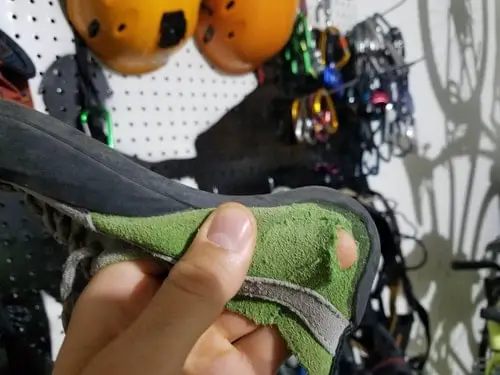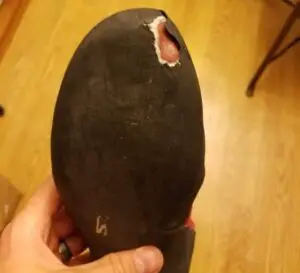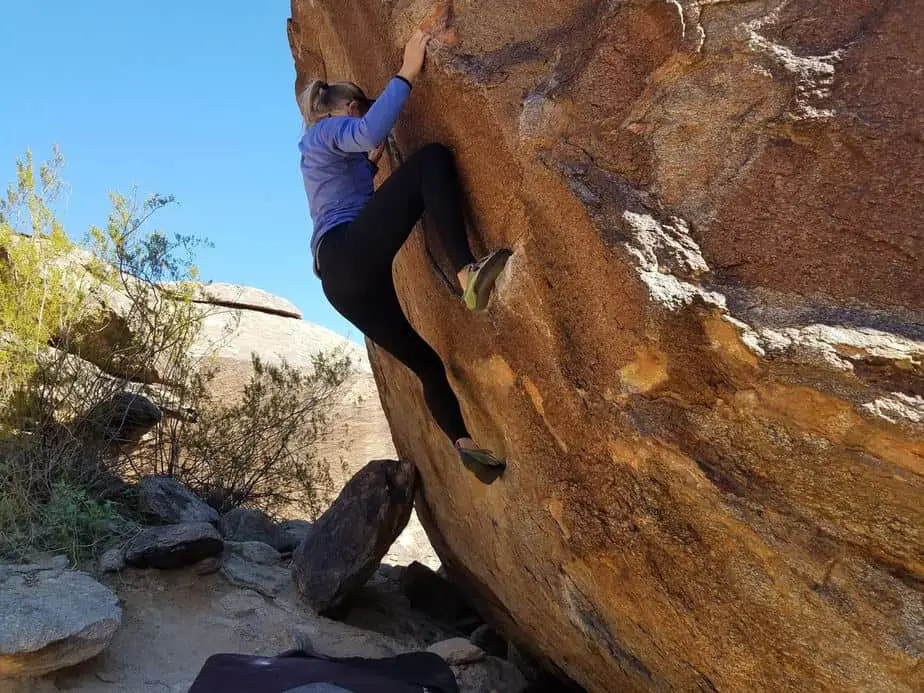Your climbing shoes are probably one of the most expensive pairs of shoes that you own, if not the most expensive. You need to take good care of them and decide if it’s worth it to resole them before they get too worn.
Signs Your Climbing Shoes Are Worn Out
- Performance losses
- The sole is peeling away from the rand
- The sole has worn through to the rand
- The rubber is hard or glossy
- There are any holes through the rand
If any of these things sound familiar, it’s time to consider getting a new pair of shoes or getting yours resoled. While getting an old pair of shoes resoled may seem like the best and most economical option, it’s not necessarily the best choice.
Climbing Shoe Wear and Tear
After you’ve climbed for a little while, you start to notice that your hands turn into paws. Callouses form as flappers become less common. Rock climbing can feel like rubbing sandpaper all over your hands and fingers. The same thing happens to your feet, but since you wear climbing shoes the wear happens to the rubber.
Climbing shoes consist of an upper section made of either leather or some synthetic material with laces or velcro closures, a hard rubber “rand” that encompasses the foot and provides structure and keeps everything held together, and the sticky rubber sole that keeps you from peeling off of the rock. The sole takes the brunt of the wear and tear when you’re climbing, and should be the first part to wear out.
Take a look at our article on how to make your climbing shoes last longer for tips that will save you money.
for tips that will save you money.

How to Tell if a Climbing Shoe is Worn Out
Performance Losses
A new pair of shoes should have an edge that you could just about shave with- high performance aggressive shoes even more so. Over time that edge wears down until it’s nice and rounded, flush with the rand. You’ll notice that you start to blow off of small holds rather easily as your performance declines, and you’ll get pretty ticked off when you smack your knees on the wall.
Remember, it’s always the shoes’ fault, not the climber!

Holes
The first thing to look for is any obvious holes in the shoes. You can wear holes anywhere in the upper (especially common with crack climbing), or anywhere around the toe box.
Any hole that goes all the way through to your foot pretty much means that it’s time to retire the shoe and start fresh. It’s best not to let the shoes go this far, because you can usually salvage them if you catch the hotspots early.
The place you’ll most likely see holes is on top of your toes. This is where you’ll sometimes drag your toes across the rock when feeling for holds. The rubber isn’t very thick. Practice making precise footwork in order to keep the rand in good shape.

Where the Sole and Rand Meet
There’s something almost poetic about the place where sole and rand meet. This is where most shoes wear out, and where you need to be vigilant if you hope to catch your shoes and get them resoled before it’s too late.
The sole is designed to be expendable, while the rand is supposed to stay permanently on the shoe. Some resolers will patch the rand, but it’s not really possible to replace outright. If you let your rand get too worn down, you’re done.
To check for wear, look at the tip of the toes. You should be able to clearly see the line where the sole is glued onto the rand. All of your fancy footwork depends on a nice sharp toe, which makes it wear out first.
Once your sole has worn so much that your footwork starts wearing on the rand, it’s time to decide what to do with the shoes. You can either keep climbing with them as the condition deteriorates until you wear through them, or send them off to be resoled.
Rubber Condition
Another thing to look for that can mean the end of a pair of shoes is the condition of the rubber. Rubber naturally oxidizes over time, which means that what was once soft, sticky, and grippy will one day become hard and brittle.
Hard rubber just doesn’t stick as well and is no fun to climb with. You’ll end up slipping off of all the holds and banging your knees on the wall, which will make you say some bad words.
You can usually tell if rubber is getting old because it starts to get a glossy sheen to it. Instead of a flat, matte black, the rubber starts to look shiny and starts to feel brittle and hard. Shoes will usually wear out before they get this old, but it’s worth checking if you don’t climb very often.

How Can You Tell if Your Shoes Can be Resoled?
Climbing shoes can be resoled if the wear and tear and damage is limited to the sole, and not the rand or upper section of the shoe. Services that resole climbing shoes often also offer shoe repairs, which include some rand repairs and even some types of repairs to the uppers including new laces or closures.
Take a look at the toe of the climbing shoe and evaluate which layer of rubber is worn through. The typical resole involves ripping or cutting the old sole off and gluing a new sole onto the bottom front section of the foot, from about the ball of the foot forward.
If you’ve got some pitting in the rubber on the sole and some wear on the toe so that the edge is gone and it is rounded smooth with the rand, then your shoe is a good candidate for resoling.
If the wear on your shoe is well into the rand, or if you can almost poke through the rand with your fingers, then you’re probably too late for just a resole. The rand is structural for the shoe, and is a lot more intensive to replace. It can be done, but a lot of the time it’s just better to get a new pair.
Is It Worth Resoling Climbing Shoes?
Resoling a pair of climbing shoes costs at least $50 in most places, plus any additional damage that needs to be repaired. Unless your shoes are worth more than $100 or hold some special sentimental value, it’s probably not worth it.
Once you get into more advanced and more expensive shoes then it’s worth considering, but at the beginner to intermediate level you are best to just buy a new pair.
Head over to our recommended gear page to see which shoes we use and recommend, and a further breakdown of the costs associated with repairing shoes versus just buying a new pair.
Related Questions
How Often Should I Replace Climbing Shoes? Climbing shoes should be replaced once they’re worn out, or once the rubber gets glossy and hard (oxidization). Keep them clean and practice good footwork and they will last longer, and resole them before you start to wear through the rand.
How do You Maintain Climbing Shoes? Climbing shoes should be brushed off or scrubbed lightly with water after each use to get particles of dirt and rock out of the sole, as this wears them out prematurely. Wash your climbing shoes every so often as needed to remove smells and excessive dirt.
How Long do Climbing Shoes Last? Climbers who climb consistently a few times a week usually go through about a pair each year. Climbing shoes can last up to ten years if they aren’t used very frequently. How long they last really depends on the level of use.
See Also:
How Can I Make My Climbing Shoes Last Longer?


